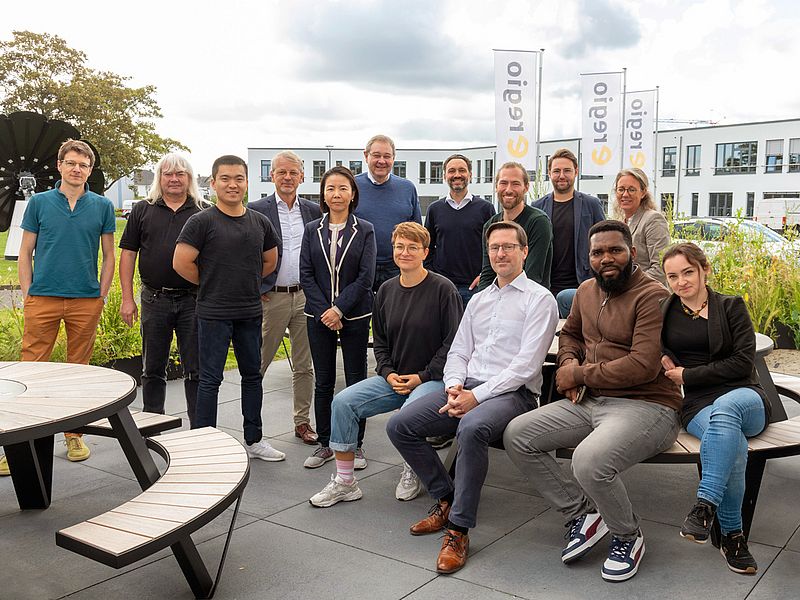In the “BEST - Blockchain-based decentralized energy market design and management structures” project, an electricity market bidding system (SMBS) was developed on the basis of a blockchain and as open source software. The aim of the project was not only to plan the electricity trading system in theory, but also to successfully put it into use. The SMBS was developed in compliance with open source criteria and thus remains open, transparent and traceable, making it reproducible for future research and application.
In this project, fortiss, led by the Reiner Lemoine Institute (RLI) in Berlin, worked together with experts from the Fraunhofer Institute for Open Communication Systems (FOKUS), the digital company OLI Systems, the Weserbergland University of Applied Sciences, the energy service provider e-regio and Energieforen Leipzig für Wissenstransfer in der Energiewirtschaft.
Various players such as companies, public institutions and private households from the e-regio supply area in the district of Euskirchen are involved in the practical test, which will run until September 30, 2024. Their electricity will be traded on a digital marketplace on a trial basis.
Generating electricity regionally and consuming it regionally
The principle: If a particularly large amount of electricity is generated from renewable energies (RE) in a region, it is possible to offer it cheaply on the regional electricity market and consume it exactly when it is generated. When used on a large scale, this stabilizes the energy system, reduces the need and costs for grid expansion and makes the energy transition more cost-effective. Businesses, public institutions and private households in particular benefit financially from the transformation of the energy market by automatically using cheap green electricity from the region when it is generated.
The electricity trading system works in two ways: personalized P2P energy trading without intermediaries and centralized trading on a marketplace. To improve the acceptance of personalized P2P energy trading, the fortiss competence field Human-centered Engineering (HCE) has investigated the potential interactive and collaborative possibilities in the energy system from a user-centered perspective and created highly personalized electricity consumption profiles. The participants can form communities (pools) according to their electricity consumption profiles and act “peer to peer”. The pooling platform developed by fortiss enables personalized energy trading while respecting the informational self-determination of users, especially with regard to their personal rights and the protection of their privacy, by dividing them into compatible groups and selecting suitable trading strategies. The pooling platform divides users with compatible profiles into pools and selects suitable bidding strategies to balance residual electricity volumes, achieve energy efficiency and promote energy democracy.
The forecasting of electricity consumption and generation, the operational control taking into account individual specifications and the creation and sending of bids are handled by software developed specifically for the project. To this end, fortiss created a forecasting model based on time series analysis and machine learning (ML), as well as algorithms for optimizing energy trading. These tools enable precise forecasting of electricity consumption and generation as well as intelligent control of energy trading, which maximizes economic benefits. Electricity that is not traded in this way can be offered on a marketplace. An energy service provider such as e-regio procures residual quantities of electricity that are not available regionally or sells surplus electricity that cannot be used regionally on the electricity exchange. This ensures security of supply at all times. Some of the algorithms used are declared as open source and can be viewed on the Github code hosting platform at the end of the project. The use of smart meter gateways is also being tested in the context of the project to ensure the secure transmission of billing-relevant data.
BEST goes into practice
BEST is funded by the Federal Ministry of Economics and Climate Protection (BMWK) and ran for almost four years. The project will finally come to an end in September with the practical test in Euskirchen. The findings from there should help to clarify open questions for the operation of local electricity markets: What requirements do companies have for such a market? How can the costs of the IT connection be reduced and processes simplified? How do company-specific requirements affect the potential for flexibilization? In any case, the results will contribute to the planned and desired energy transition.
In summary, the BEST project, in conjunction with fortiss' contribution, is driving forward the energy transition. This is made possible by the forecasting models developed by fortiss experts and the collaboration with the pooling platform. The tools and demonstrators developed and the knowledge gained from them can be used in future projects, particularly in the field of efficient and sustainable energy management. This opens up valuable advantages and potential for future partners from industry and research.



